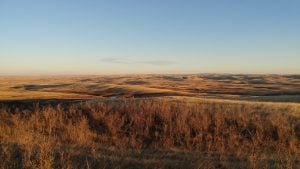
Environment
The sixth extinction
The planet is in the midst of drastic biodiversity loss that some experts think may be the next great species die-off. How did we get here and what can be done about it?
- 4895 words
- 20 minutes
This article is over 5 years old and may contain outdated information.
Environment

You’ve probably heard of wood bison, blue whales and whooping cranes, each an iconic wildlife species that makes its home in Canada. Chances are, however, that you haven’t heard of Ungava seals, kleptoparasitic wasps or Yukon Draba, three of the country’s lesser-known species.
But what do these six have in common? They’re among the 517 species found in Canada that are listed as being globally at risk in a NatureServe Canada report released in April 2017.
The report, On Guard for Them: Species of Global Conservation Concern in Canada, looks at native species of plants and wildlife that are most at risk of becoming extinct in Canada. It found that “Canada has 213 species that are endemic to the country and that are of global conservation concern,” and that British Columbia has more plants and animals that are globally at risk (231) than any other province or territory, followed by Ontario (123), Quebec (118) and Alberta (83).
While charismatic megafauna such as blue whales and wood bison tend get the spotlight, many at-risk animals, plants and lichen are barely known by anyone except the scientists who study them. This can make it difficult to get funding or public support for conserving their habitats. With that in mind, here’s a look at five species mentioned in NatureServe’s report that you may not have heard about.
Kirtland’s warbler
Considered by many to be North America’s rarest songbird, the Kirtland’s Warbler can be heard from more than 400 metres away on a clear day. Until recently, you’d be lucky to hear one at all.
The warbler is picky about trees, preferring jack pines for nesting and food. This is its biggest weakness. Jack pines tend to grow in dry, sandy habitats created through wildfires. Modern firefighting has led to fewer fires in its preferred range of Michigan and Ontario, and so, fewer places for it to live.
Conservation efforts in the United States and Ontario have seen jack pines planted in these areas to save the warbler, so populations have increased. NatureServe now classifies the bird as “vulnerable to apparently secure.”
Kleptoparasitic wasp
Several types of wasps paralyze spiders, lay eggs on them and let their young feed off the vulnerable arachnids. Kleptoparasitic wasps let other insects do the work: they find already-paralyzed spiders and lay their own eggs on the bodies.
Populations of a kleptoparasitic wasp known as Ceropales bipunctata were decreasing in Ontario and several American states, and entomologists feared the species faced imminent extinction. Then in 2015, the Atlantic Canada Conservation Data Centre found other populations along the coast of New Brunswick.
Field researchers found the wasps in 21 of 33 survey sites ranging from the Gaspé Peninsula to the Nova Scotia border and hypothesize more will be found in Nova Scotia and Prince Edward Island.
Vancouver Island marmot
These marmots like to stay rested. After hibernating all winter, they come out and spend only a couple of hours each day looking for food. They spend the rest of their time watching for predators and lounging on rocks. When predators do approach, the marmot makes the high-pitched sounds that have earned it it’s “whistle pig” nickname.
They’re also particular about where they live. They only live in south- or west-facing meadows that aren’t too mountainous or too forested, giving them a limited range on the island.
Fewer than 30 of these housecat-sized members of the squirrel family were left in the wild in 2003, but they’re making a small comeback. With the help of a captive breeding program, there are now about 200 in their small range on Vancouver Island. NatureServe classified them as “critically imperiled.”
Yukon Draba
This plant is a mustard relative that was thought to be extinct for more than 50 years. In 2005, scientists finally saw Yukon Draba again — in the same meadow it had been seen in half a century before. The plant lives only in cool meadows, where ancient beaches were left behind as glaciers receded. It doesn’t live for long and can’t disperse its seeds far from where it grows. Yet, in the past 10 years, it’s been found at 19 different sites —one more than 100 kilometres away from the original site. NatureServe has reclassified it as “vulnerable and imperiled.”
Ungava seal
The species has been cut off from the ocean for millennia, allowing it to adapt to freshwater, and it’s now only found on a few remote lakes in northern Quebec. It spends most of the winter underwater but unlike some other seals, it can’t dig holes in the ice, so it relies on open water to come up for air. Fisheries and Oceans Canada says the seal’s total population could be anywhere from 50 to 600. Its biggest threat comes from predation by polar bears being pushed southward by climate change and melting ice. NatureServe classifies the seal as “critically imperilled.”
Are you passionate about Canadian geography?
You can support Canadian Geographic in 3 ways:

Environment
The planet is in the midst of drastic biodiversity loss that some experts think may be the next great species die-off. How did we get here and what can be done about it?

People & Culture
Naming leads to knowing, which leads to understanding. Residents of a small British Columbia island take to the forests and beaches to connect with their nonhuman neighbours

Environment
Environment and Climate Change Minister Steven Guilbeault made big commitments at the international biodiversity conference held in Montreal in December. What does that mean on the ground?

Environment
Agriculture can play an important role in protecting and restoring critical habitat on the Prairies